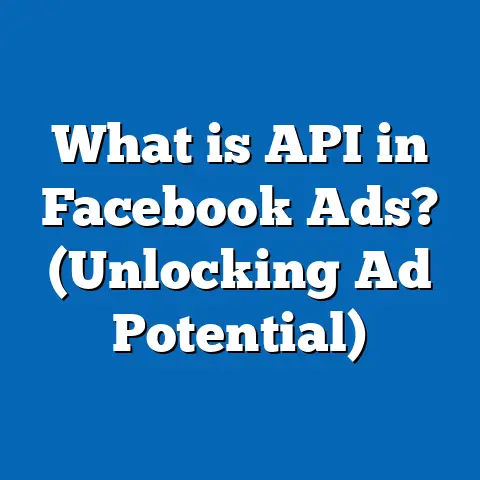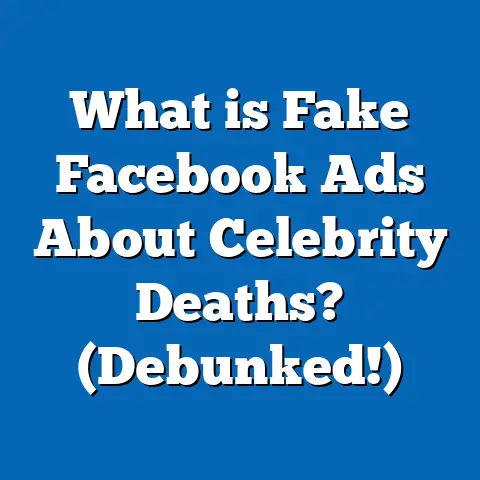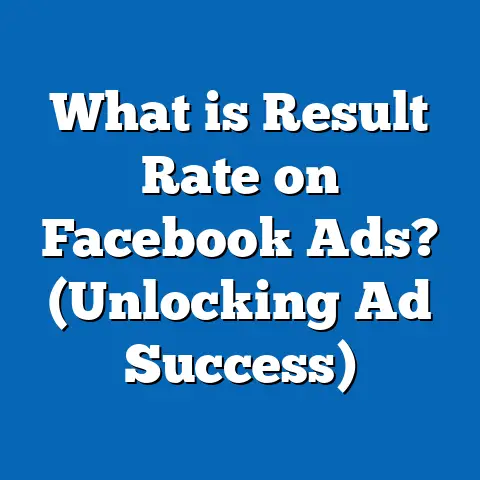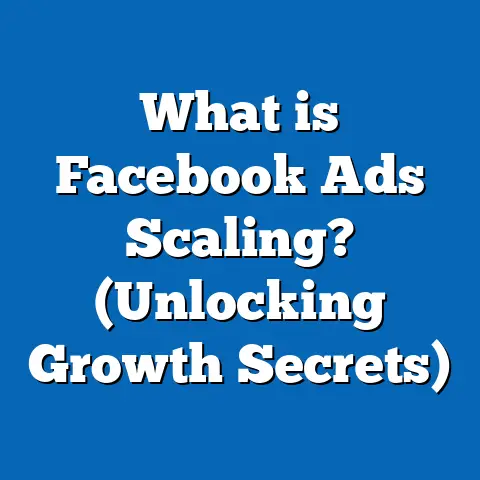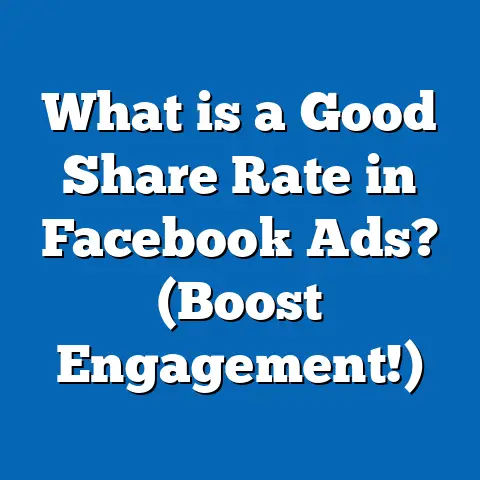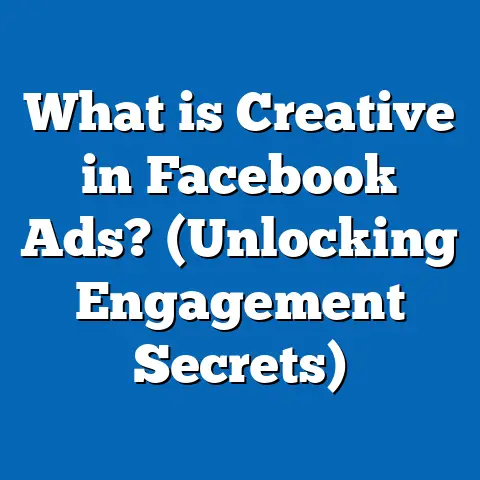What is the Correct Facebook Ad Connection Type? (A Guide)
What is the Correct Facebook Ad Connection Type? (A Guide)
Introduction: Transforming Your Facebook Advertising Strategy
Imagine turning your Facebook ads into a finely-tuned engine that not only drives traffic but builds lasting relationships with your audience. The right Facebook ad connection type can transform your campaigns from generic broadcasts into highly personalized interactions that resonate deeply with your prospects and customers. In today’s competitive digital landscape, where every ad dollar counts, targeting the correct audience is essential for success.
Facebook’s advertising platform offers a variety of connection types that enable you to reach users based on their previous interactions with your brand—whether they liked your page, used your app, or responded to an event. But choosing the right connection type is often overlooked or misunderstood, leading to wasted budget and missed opportunities.
Understanding how to leverage Facebook ad connection types allows marketers and business owners to refine their audience, boost engagement, and maximize return on investment (ROI). With data-driven insights, expert strategies, and real-world examples, this guide will equip you to select and use the correct Facebook ad connection types effectively to transform your advertising outcomes.
Chapter 1: The Basics of Facebook Ad Connection Types
What Are Facebook Ad Connection Types?
Facebook ad connection types refer to specific audience segments constructed based on users’ existing interactions with your Facebook assets such as Pages, apps, or events. They define how users are connected to your brand through prior engagement on the platform.
These connection types let you:
- Target warm audiences who already know your brand.
- Exclude current customers or highly engaged users.
- Retarget people who showed interest but didn’t convert.
- Reach audiences influenced by their friends’ engagement with your brand.
Connection types represent a foundational layer of audience segmentation in Facebook advertising that enhances relevance and performance.
Why Use Connection Types?
Targeting based on connections helps you focus your budget on people more likely to engage or convert, reducing wasted spend on cold audiences. It also allows you to tailor your message depending on the user’s relationship stage with your brand.
For example:
- New prospects can be reached through friends of page followers.
- Loyal fans can receive exclusive offers.
- App users can be retargeted with feature updates.
Data Insight: According to a 2023 report by Social Media Examiner, campaigns targeting warm connections saw 60% higher conversion rates and 30%-50% lower cost per acquisition (CPA) compared to broad interest-based targeting.
How Connection Types Fit into Your Funnel
Facebook ad connection types help you segment audiences along different stages of the marketing funnel:
| Funnel Stage | Connection Type Example | Goal |
|---|---|---|
| Awareness | Friends of Page Likers | Expand reach via social proof |
| Consideration | People who liked your page | Engage interested followers |
| Conversion | People who used your app | Retarget for purchase |
| Loyalty/Retention | People who responded to your event | Re-engage existing customers |
Chapter 2: Detailed Breakdown of Facebook Connection Types
Facebook currently offers several primary connection types, each based on user interaction with a specific asset. These are:
1. People Who Like Your Page
Definition: Users who have clicked “Like” on your Facebook Page.
Why it matters: These are often your most engaged fans — they’ve expressed explicit interest in your brand and are more receptive to your messaging.
Use cases:
- Promote loyalty programs.
- Announce new products or services.
- Share exclusive offers tailored for fans.
Data: AdEspresso’s 2023 data analysis shows that targeting page likers results in 50% higher click-through rates (CTR) compared to interest-based targeting alone.
Practical Example: A fitness apparel brand targeting their page likers with a limited-time discount code for loyal followers achieved a CTR increase of 65%, translating into a 40% uplift in sales over one month.
2. Friends of People Who Like Your Page
Definition: Friends of people who have liked your page but may not have interacted directly with your brand.
Why it matters: This group benefits from social proof. People trust recommendations from friends, so targeting their network increases the likelihood of engagement and conversion.
Use cases:
- New customer acquisition.
- Event promotion through trusted peer networks.
- Brand awareness campaigns leveraging social influence.
Insight: Marketing studies show that 92% of consumers trust recommendations from friends and family over any other form of advertising (Nielsen).
Example: A local café ran ads targeting friends of their page followers with an invitation for a free coffee tasting event. Attendance increased by 25%, largely driven by word-of-mouth within these social circles.
3. People Who Have Used Your App
Definition: Users who have installed or interacted with your Facebook-connected app.
Why it matters: These users have shown product-level interest; retargeting them can increase retention, reduce churn, and encourage purchases.
Use cases:
- Announce new app features.
- Retarget users who abandoned key actions (e.g., registration or purchase).
- Run loyalty campaigns for active users.
Data: Facebook Audience Insights reports that retargeting app users within seven days boosts retention rates by 40%.
Case Study: A mobile game developer retargeted dormant app users with personalized offers and saw a 30% increase in re-engagement within two weeks.
4. People Who Have Responded to Your Event
Definition: Individuals who RSVP’d or interacted with your Facebook event’s page.
Why it matters: These users have actively shown interest; retargeting can drive event attendance or promote follow-up actions after the event.
Use cases:
- Increase attendance through reminder ads.
- Promote follow-up products/services post-event.
- Build lookalike audiences based on engaged attendees.
Example: A tech conference used this connection type to retarget attendees with early-bird discounts for next year’s event, resulting in a 45% increase in early registrations.
- Video Viewers: Target users who watched a certain percentage of your videos.
- Lead Form Openers: Target people who opened but did not submit lead forms.
- Instagram Business Profile Followers: Target users connected to your Instagram profile.
These granular options allow even more precise targeting based on specific engagement behaviors.
Chapter 3: How to Determine the Correct Connection Type for Your Campaign
Selecting the right connection type depends largely on campaign objectives, audience maturity, and available data. Here’s a step-by-step framework:
Step 1: Clarify Your Campaign Objective
Your objective influences which connection type will best serve you:
| Objective | Recommended Connection Type(s) |
|---|---|
| Brand Awareness | Friends of Page Likers, Video Viewers |
| Engagement | People Who Like Your Page, Lead Form Openers |
| Lead Generation | Lead Form Openers, People Who Used Your App |
| Conversion | People Who Used Your App, Event Responders |
| Retention/Loyalty | Recent Page Likers or High Engagement Video Viewers |
Step 2: Understand Your Audience Data
Use Facebook Audience Insights, Analytics dashboards, and CRM data to evaluate:
- How many people like your page?
- How engaged are app users?
- Event participation levels.
Knowing these metrics helps determine if you have enough volume for each connection type and the best way to segment them.
Step 3: Combine Connection Types With Other Targeting Criteria
Connection types work best when layered with:
- Demographics (age, gender)
- Location
- Interests and behaviors
- Custom audiences (website visitors, email lists)
This ensures precision without limiting scale too much.
Step 4: Test and Optimize
Always test different connection types in controlled experiments to identify which drives the best results for your business. Use Facebook’s split testing tools to compare performance accurately.
Chapter 4: Practical Examples & Case Studies
Case Study 1: E-Commerce Brand Boosts Sales by 35% Using Connection Types
A medium-sized e-commerce retailer specializing in fashion accessories segmented their audience using connection types:
- Targeted people who liked their Facebook page but hadn’t made a purchase.
- Retargeted app users who abandoned carts.
- Excluded recent buyers from acquisition ads.
They layered these segments with demographic filters targeting women aged 18–34 in urban areas. After three months:
- Sales increased by 35%
- CPA dropped by 28%
- CTR improved by 22%
They credited connection-based targeting for reaching engaged but non-converting users more effectively.
Case Study 2: SaaS Company Improves Lead Quality by Using Event Responders
A SaaS company hosting webinars targeted people who RSVP’d but didn’t attend. By retargeting them with recorded webinar ads and follow-up offers:
- Lead conversion rate increased by 40%
- Cost per lead reduced by 20%
This approach maximized value from event engagement signals.
Chapter 5: Best Practices for Using Connection Types
Use Exclusion Targeting to Avoid Audience Overlap
Avoid showing acquisition ads to existing customers by excluding “People Who Like Your Page” or “Event Responders.” Overlapping audiences lead to higher frequency and user fatigue.
Refresh Audiences Regularly
People’s behaviors change; update connection-based audiences every few weeks to maintain accuracy and effectiveness.
Segment by Recency
Target users based on how recently they engaged:
- Ads for recent page likers should be different than ads for those who liked months ago.
Recency segmentation reduces wasted impressions and boosts relevance.
Combine Lookalike Audiences With Connection Types
Create lookalike audiences from high-value connections (e.g., purchasers or frequent app users) to scale campaigns while maintaining quality leads.
Chapter 6: Common Mistakes & How to Avoid Them
- Ignoring Warm Audiences
Many advertisers focus solely on cold prospecting but miss out on higher ROI opportunities by neglecting connected audiences.
- Overlapping Audiences
Failing to exclude overlapping groups causes inefficient ad delivery and inflated costs.
- Not Testing Different Connection Types
Assuming one connection type fits all campaigns limits performance potential.
- Neglecting Data Analysis
Skipping regular review of audience insights leads to missed optimization chances.
- Not Refreshing Audiences
Old data means less effective targeting over time.
Chapter 7: Comparing Facebook Connection Types With Other Platforms
Google Ads Customer Match vs. Facebook Connection Types
Google Ads uses Customer Match based on email addresses or phone numbers uploaded by advertisers. This is precise but static and limited to known customers.
Facebook’s connection types are dynamic and behavior-based, enabling targeting of users who interacted in various ways without needing personal data uploads.
Summary:
| Feature | Google Ads Customer Match | Facebook Connection Types |
|---|---|---|
| Data Source | Uploaded customer lists | User interactions (Page/App/Event) |
| Dynamic Updates | Manual | Automatic |
| Granularity | Limited | High (multiple interaction types) |
| Privacy Restrictions | Strict | Compliant with platform policies |
LinkedIn Matched Audiences vs. Facebook Connections
LinkedIn provides matched audiences via website visitors, contact lists, or account targeting but lacks social interaction-based segments like Facebook’s “Page Likers.”
Facebook’s larger user base and richer interaction data offer more precise warm audience targeting options.
Chapter 8: Latest Trends & Features in Facebook Ad Connections (2024)
Facebook continues evolving its ad platform with new connection-related features:
- More granular video engagement options: Target users who watched specific video segments (e.g., 25%, 50%, 75%, 95%).
- Instagram integration: Cross-platform connections allow targeting followers on Instagram alongside Facebook.
- AI-driven recommendations: The platform now suggests optimal connection types based on campaign goals automatically.
- Enhanced event connections: Ability to target attendees based on specific actions during events (e.g., check-ins).
Meta’s Q1 2024 report states advertisers using these advanced connection features achieved an average 20% lift in return on ad spend (ROAS) compared to traditional methods.
Chapter 9: Technical Overview – Setting Up Connection Type Targeting in Ads Manager
Step-by-Step Guide:
- Go to Facebook Ads Manager and create a new campaign.
- Choose your campaign objective (e.g., Conversions, Traffic).
- In the ad set section, scroll down to the “Audience” section.
- Click “Connections.”
- Choose from:
- Pages
- Apps
- Events
- Select connection type:
- People who like your page
- Friends of people who like your page
- Exclude people who like your page
- People who used your app
- People who responded to your event
- Layer additional targeting parameters as needed.
- Save audience and proceed with ad creation.
Important Tips:
- Use clear naming conventions for each audience segment.
- Duplicate ad sets when testing multiple connection types.
- Monitor frequency and relevance scores closely post-launch.
Chapter 10: Measuring Success & Optimization Strategies
Key Metrics to Track:
- CTR (Click-through rate)
- Conversion rate
- CPA (Cost per acquisition)
- ROAS (Return on ad spend)
- Frequency (to avoid fatigue)
Optimization Tips:
- Pause underperforming connection-based segments quickly.
- Increase budget gradually on high-performing segments.
- Refresh creative assets regularly to maintain engagement.
Conclusion: Final Thoughts & Next Steps
Facebook ad connection types are powerful tools for refining audience targeting and increasing advertising effectiveness. By understanding each connection type’s purpose and strategically applying them based on campaign goals, marketers can significantly improve engagement rates, reduce costs, and drive higher conversions.
To summarize:
- Identify campaign goals clearly before choosing connection types.
- Use data insights to analyze audience behavior.
- Combine connections with other targeting layers for precision.
- Regularly test, analyze, and refresh audiences.
- Avoid common mistakes like overlap and neglecting warm audiences.
Taking these steps will help you harness the full potential of Facebook’s powerful advertising platform and turn your campaigns into high-performing marketing assets.
Would you like me to create some downloadable templates or checklists based on this guide? Or provide examples of ad creatives optimized for different connection types?

